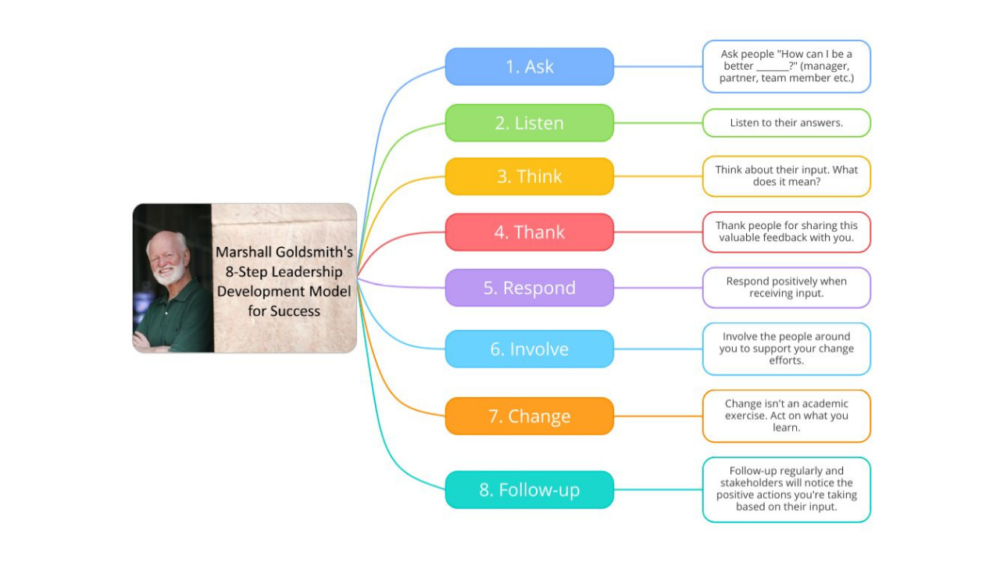Leadership Development Model template

The Leadership Development Model template encourages you to become a better leader by asking others to identify your key areas for improvement, so you can make positive changes that will make a difference. This template was created by the world-renowned leadership expert and coach, Dr. Marshall Goldsmith.
What is the 8-Step Leadership Development Model?
There’s always room to develop your skills – even if you’re already a successful team leader. By being able to identify where you need to make improvements, you can ensure that you retain your value to your organization, as well as bring value in new and exciting ways. However, as a leader, it’s also your responsibility to ensure that you’re able to do just that; lead. Without your team or the other people around you, you would simply have no one to lead. This is why it’s also vital that you focus on how you can develop them too.
Unfortunately, with the demands on leaders constantly increasing, it can be hard to find the time you need to focus on change.
This is why I created the 8-Step Leadership Development Model for Success. As its name suggests, this framework involves just eight simple steps that any leader can complete: Ask, Listen, Think, Thank, Respond, Involve, Change, and Follow Up. Perfect for those with limited time, my framework encourages you to make the most of the resources you do have – the people in your organization. It requires you to gather their opinions on how you can improve, then work with them to ensure that you’re taking the necessary steps to make positive changes.
Why should you use the 8-Step Leadership Development Model?
My 8-Step Leadership Development Model has already worked for thousands and thousands of people, and I want to ensure that it continues to help others. This framework can be used by various types of leaders in organizations of all shapes and sizes to help them take a step back from the hustle and bustle of their everyday responsibilities and focus on improving, rather than simply getting things done. It can help to ensure that they’re constantly developing their skills, so they continue to prove their worth within their organization and become the best leader they possibly can be.
Sometimes, we can be blind to the things that are most obvious; instead, we need an outside spectator to point these out to us. So, by asking members of your team and others around you (who often know you best) what you can do to become a better leader, you can ensure that you’re making positive changes that will really make a difference. Additionally, by working with others to identify your weak points, you’ll be more likely to hold yourself accountable for your actions – meaning you’re far more likely to make these changes and stay focused on your end goal.
How to use the Leadership Development Model template
My Leadership Development Model template is set out in the format of a colorful mind map with each step outlined to guide you through the process. Discover how to use my template to make positive changes below.
To access the template, sign up to Ayoa. Once you've signed up, navigate to the homepage to create a new whiteboard, mind map or task board and choose this template from the library.
ASK. Start by asking people “how can I be a better manager/partner/team member?” and add their answers to the mind map. To do so, hover over the box (or ‘branch’) that contains this question and click the green arrow next to it to add a new connected branch. You can then type your answer in the box that appears. Do this as many times as you need to ensure that all the answers you collect are in separate boxes.
LISTEN. Take some time to reflect on the answers you’ve gathered and ensure that you fully understand them. Again, you can add additional branches to make notes if needed. To keep things simple, you can also add hidden notes, comments, and checklists to the individual branches of your mind map that can only be accessed by opening the side panel. To add these, click on a branch, then on the paint brush icon in the menu that appears.
THINK. Take some time to consider what their input means. Again, add notes to the mind map if needed and for any of the following steps.
THANK. Let people know that you appreciate them taking the time to provide you with their valuable feedback by thanking them for sharing it with you.
RESPOND. Make sure you respond positively when receiving this input.
CHANGE. Remember; change isn’t an academic exercise. Act on what you learn. Use the mind map to define the steps you want to take going forward, then turn them into tasks you can manage in a dedicated task board in Ayoa.
FOLLOW-UP. Follow-up regularly and stakeholders will notice the positive actions you’re taking based on their input.